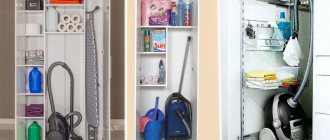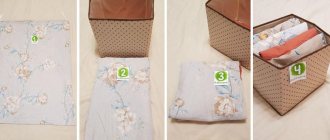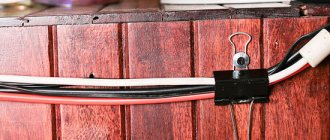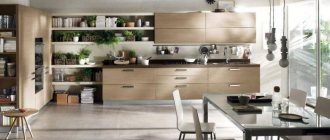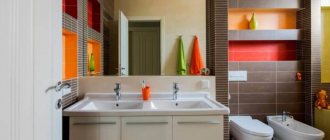Row or pyramid of pans
There are two important things to consider when storing pots in the kitchen: they need to be within reach without cluttering up the space. As a rule, all zealous housewives quite quickly get rid of pans that have become unusable: with chipped enamel, burnt ones, with a damaged non-stick coating, a handle melted due to carelessness, inappropriate in volume, etc. Even the appearance of the pan matters for a modern kitchen. Only the “workable” and beautiful ones remain, but quite a lot of them are required. There are four most well-known space-saving ways to store pots:
- Arranged in the form of a pyramid on shelves of sufficient height - a “matryoshka” set.
- Low shelves in lower kitchen cabinets that hold a row of pots.
- Drawers in lower kitchen cabinets.
- Hanging in various places in the kitchen (under the ceiling, above the window, on the wall).
Those who like to cook at home, to simplify the storage of kitchen utensils, buy sets of saucepans. These sets are designed in such a way that one of the pans can easily fit into the other - like a nesting doll. If the cabinet space and shelf height allow, then each pan is placed one on top of the other along with the lid. The lid can be turned over and the next pan can be placed on top of the closed bottom one. If space is limited, you can simply stack the pans together - one inside the other, and store the lids separately. However, pots that do not fit into this pyramid may remain in the kitchen.
Many people are accustomed to storing a row of pots on large, but not too high shelves. Of course, it’s not very convenient if the cabinet is deep, then the second row of pots requires additional effort to remove them. It’s good when the kitchen is designed in such a way that there is a side cabinet that opens very wide. Its hinged (semicircular) door opens the shelves with cooking utensils almost completely.
The best option for storage is a deep pull-out shelf designed for the tallest pan. The entire set of pans is immediately visible on it. If there is no pull-out shelf, you can buy (or make yourself) an additional system that will pull out from the cabinet. It is very convenient to store pots in the kitchen where they are within maximum access, on the lower pull-out shelves, not far from the hob.
Drawers
Kitchen furniture designers make special drawers for large utensils. It is important not to miss this moment when ordering a headset. It is advisable to calculate the height of the boxes and depth in advance. It makes more sense to order one large box for frying pans rather than several small ones. We recommend that you immediately specify the presence of dividers and hooks.
Do you keep your kitchen utensils in order?
Not really
Storage methods:
- matryoshka _ Classic stacking. It has many disadvantages - it is difficult to remove the lower pans. Often only the top cookware is used. Soot remains inside the containers;
- vertical storage . The inside of the drawer resembles a basket with dividers. The most convenient option. All the frying pans are in sight, making it easy to get what you need. Lids from pots are also inserted into the dividers; there is room for removable handles and stands.
Pan storage box
You can make a kitchen drawer with your own hands. An excellent option for furniture purchased a long time ago. The advantage of this method is the ability to accurately calculate the size, think through the placement of dividers and hooks, taking into account the amount of your dishes.
Short answer. To store pans in the kitchen, use built-in drawers, cabinets, Ikea baskets, rails and rods with hooks. Can be stored suspended under or above the window, on the side walls of the set, or on wall shelves.
Pans on the wall or in the cabinet
The hole at the end of the handle, which almost every frying pan has, is a hint for the owner - the frying pan must be placed on a hook.
Where to store frying pans in the kitchen, that is, how these hooks for household utensils will be located, is up to the owner. It is important to understand how many hooks are required and exactly how much space will be allocated for the pans. After all, some people prefer a microwave or a double boiler, while for others, large and small frying pans are indispensable assistants in the culinary art. There are six common ways to store pans:
- Permanently attached hooks.
- Rails with hooks.
- Hanging boards for hooks.
- Specially equipped shelves with organizers.
- Stands for frying pans.
- Placement in the oven.
Many or few pans - it doesn’t matter. In any case, ordinary permanently fixed hooks on the wall will help.
The practice of many households has become the organization of kitchen space using rails with hanging hooks: they have proven themselves well when placing various kitchen tools, including frying pans and stewpans. Sometimes it becomes necessary to change the location of the hook - when changing the number of pans or their size. This option is always available when placed on a railing.
But the necessary variability can be provided not only by railing, but also by a metal grate or board with holes mounted on the kitchen wall.
Fixed hooks, grates, boards or rails are usually located on the wall or on the side panel of a kitchen cabinet.
However, the option with open hooks or rails is not suitable for everyone. After all, you can hang a frying pan on the wall as a decoration only when it has been cleaned to a shine and all deeply ingrained dirt has been removed. And this is a labor-intensive task.
To hide unsightly dishes, a rail on the inside of the cabinet door or a cabinet with a pull-out rod is suitable. You can hang all your pots and pans with handles on these “hidden” hooks.
Those who want to simply place the frying pans rather than hang them should be reminded that manufacturers do not recommend stacking one on top of the other: this will damage the frying pans with a non-stick coating.
A specially equipped cabinet for storing pans in the kitchen comes to the rescue, with relatively small shelves designed for each of them separately. Or a special stand located in the cabinet, on which each frying pan will take its own place. There are different types of stands: some provide for horizontal placement, while others are made on the principle of drying dishes, and in them the frying pan is placed on its side.
In a rationally organized kitchen, frying pans that are used every day, arranged in different ways, end up not far from the stove or sink. Even better - between them. If the pans are not hanging on the wall, then, as a rule, they occupy the lower kitchen cabinets, and sometimes take root in the oven.
On a forged hook
Calculate the exact cost of repairs using an online calculator
and receive a free detailed estimate for repairs
Calculate
The abundance of wood in kitchen decoration is often accompanied by copper utensils and accessories. In this case, of course, there is also no need to hide beautiful frying pans, but the copper ones will decorate the interior more than serve their intended purpose. A forged shaped hook can be attached to a ceiling beam and you can use frying pans to create an interesting composition. Other copper elements are also very desirable in such a kitchen: faucets, fittings, finishing of wooden furniture.
Photo: forbes.com
Placement of covers
The simplest placement option is to place all the lids next to the plates in a hanging rack for drying dishes.
If this shelf is long enough, then there are no problems: the lids are washed, they are not far from the plates, everything is well systematized. All objects are immediately in front of your eyes, they are easily accessible. But the cells for plates may be too narrow, which means they are not suitable for volumetric lids. There is a high probability that they will fall on plates: it is so easy to break more fragile dishes. According to the principle of conventional drying, special stands for lids are organized. They can be inside a drawer or stand alone on the kitchen work surface. There are several successful ways to place lids:
- Special stands on the work surface.
- Separate pull-out shallow shelf in the closet.
- Rails into which covers can be inserted.
- Angled hooks.
- A narrow compartment inside a pull-out shelf with pots.
- Decorative narrow shelf.
- Hanging stand for lids of different diameters.
- The special shape of the lid handle allows you to hang it on a hook or on the handle of a frying pan.
Sometimes a separate retractable shallow shelf is loaded with lids. If you remember exactly which pan each of them belongs to, then this is a quite passable option, although when the box moves, the enamel lids may chip. It is somewhat better when the drawer for storing pots has a narrow compartment on the side for free-standing lids.
A good option is the same roof rails: covers will be placed behind them, without any additional devices. A replacement for roof rails are two stationary hooks, attached at an angle on the left and right so that the lid is inserted into them like into grooves. Another good storage method is a narrow hanging decorative shelf; the lids will stand on it as an addition to the kitchen design.
The ideal option for storing pot lids in the kitchen is a special hanging stand, which has cells for lids of different diameters. This stand can be placed anywhere - on the wall or on the inside of a cabinet door, on a side panel or on a rail. You can provide for the placement of a hanging stand when drawing up the layout of a new kitchen. But even in a habitable space there is always a suitable place for it.
Kitchen cabinet shapes for pots and pans
There are various forms of cabinets:
- straight;
- L-shaped;
- trapezoidal;
- docking
The straight cabinet for pots has a classic rectangular shape and is easily attached to the side of the outer elements of the set. The main advantage of a straight wall-hung cabinet is its convenient combination with a corner sink or a floor-mounted cabinet with a sink. The negative point of this cabinet is the inaccessibility of its side wall. Straight cabinets are also called docking cabinets. They are compatible with any headsets.
L-shaped cabinets follow the shape of the right angle of the wall.
Their advantages:
- easy access to the interior, even when the door leaf does not open completely;
- a wide range of fittings, which allows you to use modern decorative details and turn the cabinet into a room decoration.
There is a minus - small storage space. However, the creation of new types of construction makes it possible to use this space effectively.
The trapezoidal cabinet has a beveled corner on one side. It is characterized by good functionality:
- other modules are simply connected to such a cabinet;
- If such a wall cabinet is placed above the sink, the front part of the trapezoid will be used to store dishes, and the sides will be used for useful kitchen items.
The only disadvantage of trapezoidal cabinets and cabinets is their large volumes. They are difficult to use in a small modern kitchen.
New acquisitions
When purchasing a new set of frying pans or saucepans, you should pay attention to their lids. There is an interesting option when they can be placed on the handle of a frying pan when storing it. This is provided for by the very shape of the lid handle - it represents a “bridge”: the handle of the frying pan is quietly placed under it, which, in turn, will be located on the hook.
A useful thing in the household is a special stand under the lid for the time when the cooking process itself is in progress. Usually, stirring with one hand, hold the lid in the other. But it is much easier to put it on a plate of a suitable size or a special stand, in which the hot lid will find a stable and safe position. These new items are on sale.
Cast iron cookware has come back into fashion. She will have to be given special respect and placed along with the lids on a separate bottom shelf in the closet. It is not advisable to separate a cast iron pan with its “original” lid. This suggests not only the significant weight of this cookware, but also that a closed cast-iron pan will be better preserved in this way.
Fastenings on the inside of cabinets (rails, strings, rubber band)
The storage method on the cabinet doors outside and inside is carried out using wooden or metal crossbars. Ready-made kits are sold in specialized and construction stores. It is enough to secure the fasteners to arrange a place for the covers.
Railing is a crossbar that is attached at a short distance from the surface. The lid will be placed in the gap between it and the door and will be held on by the handle on the surface. Accordingly, larger caps will require more clearance.
Railing is a crossbar that is attached at a short distance from the surface.
Buy roof rails with a variety of latches that are adjustable to create storage space.
Instead of a solid crossbar, belts, strings, and strong cords are used. Rubber strips are elastic, it is much easier to fasten and place the lid behind them. The main thing is to pull it tight so that they press the accessory to the surface of the door. Rubber bands are a practical option because they allow you to accommodate a variety of lid designs.
Extravagant storage methods
Placing pots, saucepans and frying pans under the ceiling or on a window is an option recommended by some designers, recalling that this is a “country” style.
But taking into account traditional, as well as ergonomic ways of organizing kitchen space, such methods do not look very practical. Especially for women: objects are too high, not “at hand”, which means they will have to be reached with a stepladder. Dishes that are not put away in cabinets and not used daily will still collect dust and soot. And this plaque will need to be periodically removed: remove, wash and again place all “suspended” objects in place. It should be taken into account that this arrangement of pots and pans blocks the lighting - natural and additional.
However, no matter what storage method is chosen, it should suit the owner or mistress of the kitchen. Combining design and practicality is an interesting task.
Photos of cabinets for pots and pans
<
>
Modern storage systems and the latest fittings, braking, sliding and movement mechanisms can turn an ordinary kitchen set into a comfortable, organically thought-out type of furniture. Cabinets equipped with organizers create perfect order in the room and make it easier to access any pan.
Other ideas
Modern non-stick coatings are not very resistant to mechanical damage. Especially if you store such dishes according to the matryoshka principle. Therefore, it is better to purchase special separators that will protect Teflon or ceramic coatings from scratches, chips and other troubles.
If you have a large amount of dishes and no free space, saucepans can be placed on top of the cabinets. But then they will have to be washed more thoroughly to remove dust, particles of grease and soot.
There are many ways to store pots in the kitchen, which should be selected based on your capabilities, imagination and layout. The main thing is not to forget about the ease of use of the dishes and keeping them in proper condition.
Storing pots in plain sight
There are housewives who are absolutely not embarrassed by empty pots and pans in their field of vision. Then a crossbar above the window sill is suitable for them.
This type of storage of pots and other utensils cannot be called very hygienic and aesthetically pleasing. But for a country house it is quite suitable. However, you need to be prepared for the fact that such storage will cover part of the window opening, which will make the room darker.
You can also adapt some kind of niche for storing dishes or simply keep them suspended above the table.


